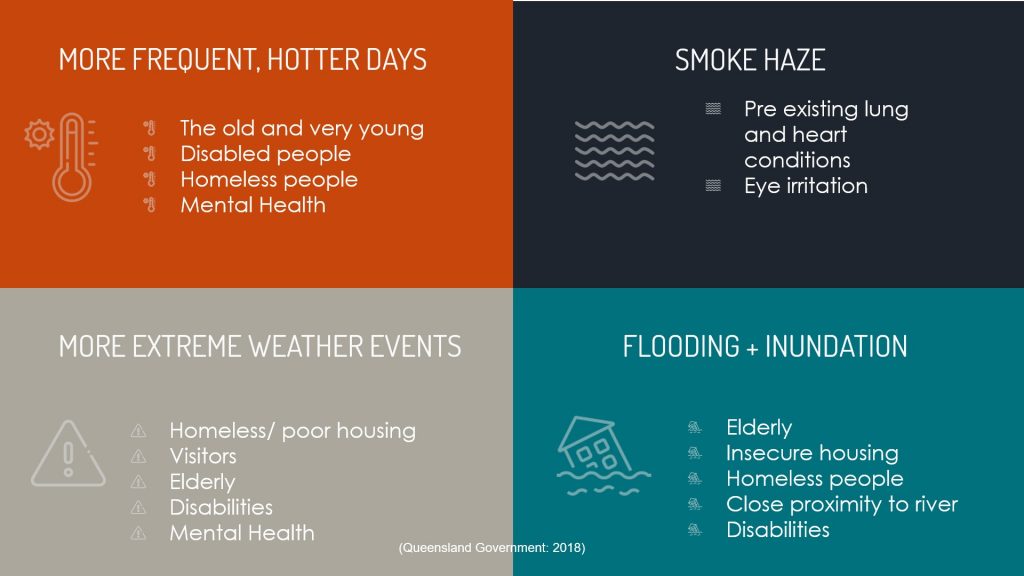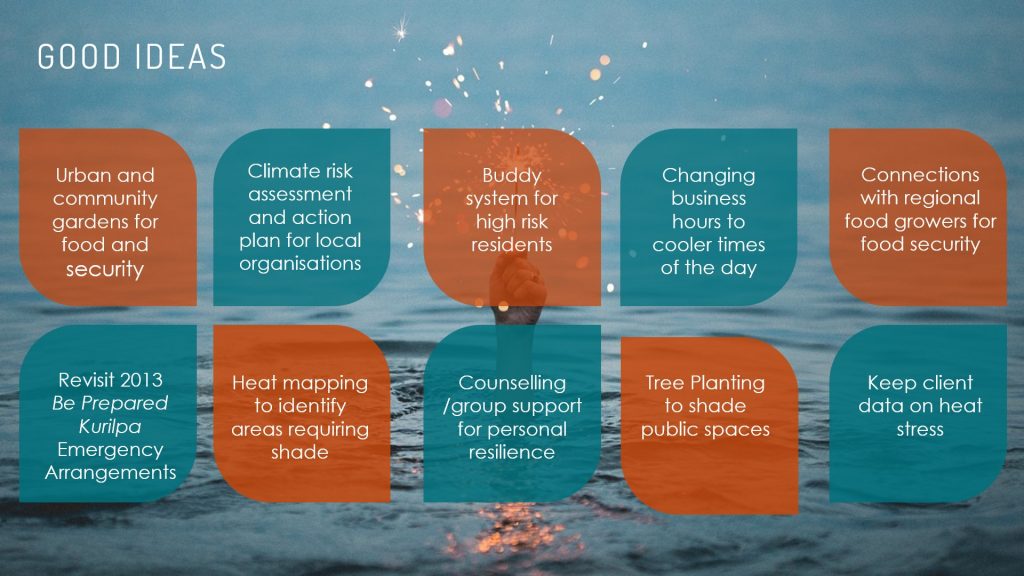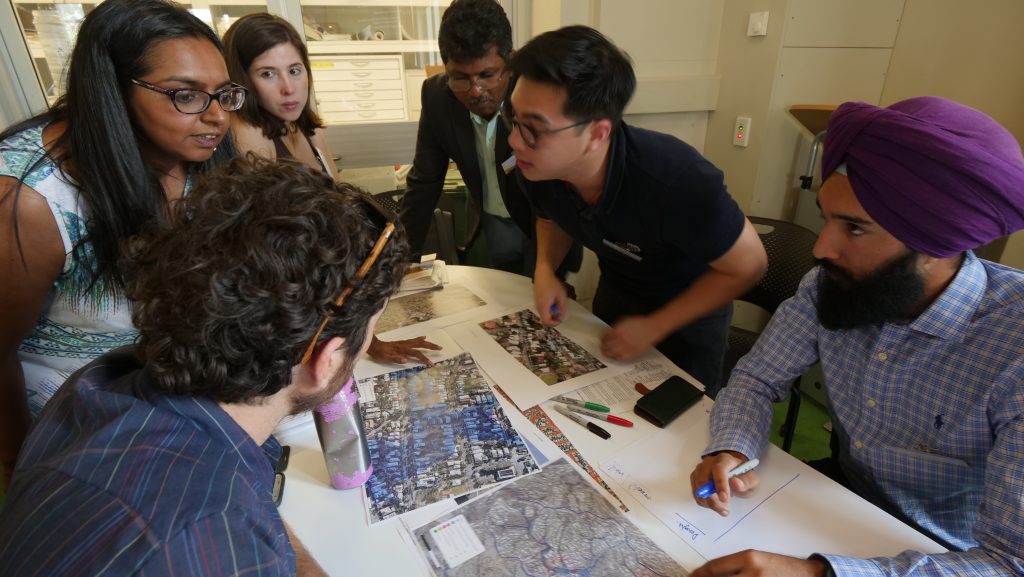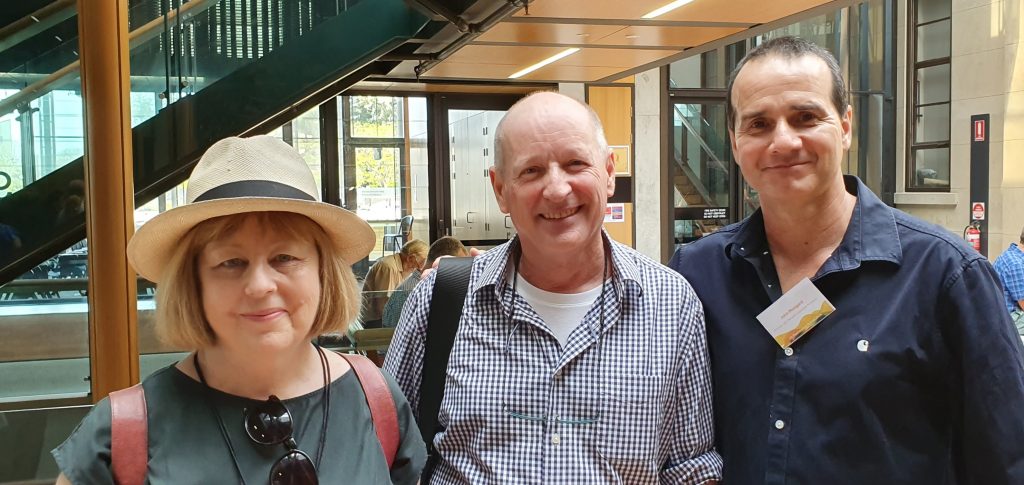What will climate disruption mean for us in Kurilpa? Kurilpa is an Aboriginal word meaning place of the fawn-footed melomys or native water rat, the kuril. It refers to the suburbs on the river-bounded peninsula of Highgate Hill, South Brisbane, West end and Hill End.
Under a smoky Brisbane sky a few Wednesdays ago over a hundred (two?) people gathered to ask what the impacts from climate disruption will mean for two local areas – Kurilpa and Rosalie, now and in the medium and longer term? How well equipped are we to cope with the weather changes booked in as a result of deepening climate change? What needs to be done to adapt to climate change so we are all safe and resilient?
These questions were the focus of an all-day forum Shifting Climate, Shifting Places held at Global Change Institute, University of Queensland on the 20th of November. Attendees were from a broad range of backgrounds including urban planning, landscape design, climate science and community organisations. The forum forms part of a bigger collaborative process for neighbourhood action on adaptation, building resilience in the face of climate disruption.
Not good news – heatwaves, drought and storms
What weather changes are we expecting? In response to November’s bushfires along the length of Eastern Australia we have seen that words like ‘unprecedented’, ‘catastrophic’ and ‘devastating’ failing to adequately describe the actual conditions experienced by front-line people like the fire-fighters and people who lost everything. In his climate overview presentation at the summit, Bob Speirs gave us a succinct picture of the weather ahead for us:
- hotter hot days, more hot days
- more dry times, drier dry times and harsher fire weather
- heavier downpours, bigger runoff events, potentially bigger flood events and cyclones
- rising sea level, more frequent sea level extremes.
We often hear that ‘the future has arrived’. As climate disruption continues the picture that emerges is that there will not be a so-called ‘normal’ weather pattern. Nor will there be a stable ‘new normal’ because these weather extremes will continue to trend upwards, driven by the greenhouse gas emissions which continue to disrupt the climate.
What does this mean for Kurilpa?
John Mongard, landscape architect and strategist for the local Green Space Strategy, spelt out the climate-relevant features of Kurilpa as:
- The River on three sides, running out of a big catchment and being tidal, so our river is a force majeure for the local population, and for the city as a whole
- Our landscape of ridges and gullies creating different micro-climates locally – the ridges get the breezes, the gullies less so
- An increasing percentage of concrete covering our land as a result of urban concentration, hardening and heating all surfaces: decreasing percentage of green space, increasing infill in back yards, infill of whole areas that were natural
- Heavier reliance on bigger and more stormwater pipes, reduction in the soft surfaces that allow water to filtrate into the ground
- Many long-established buildings have habitable floor areas below the flood lines and flood line estimates are changing in light of rainfall predictions.
James Davidson, Brisbane architect and water management expert, outlined new ways to think about water – its collection, movement and discharge from our hardening urban environment. This challenge will only increase with rain events predicted to intensify and increase.
Business as usual or even minor modifications to things now won’t get us to where we need to be
One observation John made was that things he is designing now for predicted weather extremes in ten years may be inadequate when tested in ten years’ time. The pace and seriousness of weather changes were making predictions difficult to rely on. How then do we ‘plan’ to be resilient as a community?
Who is vulnerable?
Our population is growing much faster than the rest of Brisbane’s. It is set to be 40 000 by 2030, so how and who do we plan for in terms of weather extremes? Pam Bourke, community development specialist, scoped out a picture of our community’s vulnerability. Groups amongst us who are most likely to be most negatively affected by these weather extremes include those who are:
- Young demographic combined with an older cohort (9% aged 65+)
- Housing challenged, those who are homeless or housing stressed
- Tenants particularly as many tenants have no ability to modify their accommodation to deal with heatwaves, grow their own food, or to move their electricity supply onto solar power
- Living isolated (32% lone households), those without modern communication
- Dealing with mental health issues or disabilities,
- Outdoor workers, tradies
- People newly arrived, moving through or who are not connected into the community.
Kurilpa is a remarkably diverse place and it does have other groups of people who are less vulnerable. For example, they have access to information and can make active choices about their lifestyles. Many of these are well connected into the community, they have capacity to take action for themselves and spare capacity to help others. They are considered to be a resource for resilience building within the Kurilpa community.
What does our resilience look like?
Resilience was defined on the day as being able to face change and to return to core functionality after that change. Things may never be the same people are able to function in the ways they need to e.g. kids to school, journey to work, communicating and running a business etc.
Resilience as a concept applies to individuals and larger groups. An assumption in the field of resilience planning is that individuals often have to reach out to groups to cope, to support their resilience in the face of an event. Collaboration and collaborative efforts have a big part to play in resilience planning for communities.
Pam Bourke gave one picture of resilience. In January 2011 about 15% of Kurilpa peninsula was flooded. The Mud Army helped with the big clean-up. There was a great deal of collaboration between community, business, not-for-profits and levels of government to help people – firstly when they needed to prepare for the floodwaters and afterwards to get back on their feet, to being able to function in their local area again.
Capital ‘A’ for Adaptation
Is the answer then for each of us to install air-conditioning and keep a torch handy?
Participants working in table groups explored the big questions arising out of the features of our peninsula, its land and its community, in the face of weather extremes, under three scenarios for 2030:
- Storms and drought
- Landscape and vegetation needs of
- Heat extremes
Some initial ideas included:
- re-thinking our buildings and transport for resilience
- rethinking our infrastructure for water management
- greater localisation of food growing, food and waste recycling, at street level and beyond
- greening for shade, for pedestrian and cycling networks and green space linkages, for refugia for fauna and flora, with biodiversity and food growing not in competition
- water collection and water discharge, living with increasingly less and periodically more water than we want
- concerted work to set up community hubs for us to retreat to, revive and reconnect with our community
- more specific disaster preparedness especially for the before and after of floods, storms and heatwaves, building designs that respond to the new understandings emerging about climate disruption and heat, storm and flood risks
- using art to help people interpret changes to their environment, to communicate community values about change, to anticipate and respond to disasters
- emphasis upon neighbour to neighbour care, a buddy system to high risk residents
The last word
The vulnerability of our local area to extreme weather events arising inevitably out of the climate disruption ahead is front of mind for us all. Some people and places are highly vulnerable, other things will cope better. We will all face small changes, some of which we can control at home. But some changes have the potential to hit harder and, in the process, to knock out working parts of our community.
The forum participants want to make things happen, not to keep doing things as we have been. Today’s ways will not get us the resilience we will need. Design of the most effective public action is a priority for this group and there is to be a follow-up collaboration forum in the first quarter of 2020. This collaboration for neighbourhood action will focus on Designing for Climate Adaptation and will be coordinated by the leaders of this forum.
The last word goes to Aunty Ruby Sims, Munanjali elder, and what she said in her Acknowledgment of Country at the day’s opening. When she spoke about the cross-roads arrived at in our relationship to Mother Earth, she held out her arms and said loud and clear to all of us:
‘We’ve waited a long time for you mob! Now is the time for the conversation that Aboriginal people have been waiting over 200 years for….
How to participate
The organisers of the UQ summit are now talking with local community groups in Kurilpa about a 2020 workshop. To get involved in coming workshops, talk with your local organisations. More to come on this.
Click Here to hear more here from John Mongard, Pam Bourke and Bob Speirs
Thanks to Mark Doyle for this video.
Thanks to Pam Bourke for the feature image and slides
You can share to social media using the buttons below.







